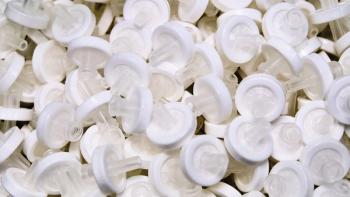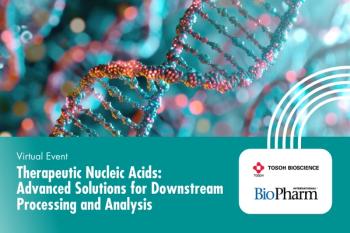
- BioPharm International-10-03-2009
- Volume 2009 Supplement
- Issue 7
Antibody Purification Using Membrane Adsorbers
A membrane adsorber in retention mode can be used efficiently in a commercial antibody manufacturing process.
ABSTRACT
Most antibody manufacturers currently use a three column platform comprising Protein A affinity chromatographyfor product capture, followed by anion exchange (AEX) chromatography in flow-through mode to extract negatively charged contaminants, and then cation exchange (CEX) chromatography or hydrophobic interaction chromatography (HIC) in retention mode to remove positively charged contaminant species. This article presents a new process that uses membrane adsorbers for both flow-through and retention steps in antibody polishing. The process shows that a membrane adsorber in retention mode can be used efficiently in a commercial antibody manufacturing process.
Antibodies have been at the forefront of the biopharmaceuticals market for most of the last decade, and judging by the hundreds of antibody-based products at all stages of the clinical pipeline, these will continue to dominate the market for the foreseeable future.1 About half of all biopharmaceutical process trains have been designed for the production of monoclonal antibodies, and the industry has focused on a small number of platform technologies optimized to squeeze every last milligram of product from the feedstream.2 The vast majority of companies currently producing monoclonal antibodies (MAbs) use a three-column platform approach comprising Protein A affinity chromatography for product capture, followed by anion exchange (AEX) chromatography in flow-through mode to extract negatively charged contaminants such as host cell protein (HCP), endotoxins, host DNA, and leached Protein A, and then cation exchange (CEX) chromatography or hydrophobic interaction chromatography (HIC) in retention mode to remove positively charged contaminant species including residual HCP and product aggregates.
SARTORIUS STEDIM BIOTECH GMBH
One disadvantage of this approach is that as cell culture titers increase, the downstream process becomes a bottleneck and costs increase in line with production scale, i.e., there is no economy of scale. The industry has been evaluating strategies to address such capacity and cost issues and has investigated different approaches, some at the low-technology end of the spectrum and others at the high-technology end. Among the latter, membrane adsorbers offer a flexible and cost-effective solution to some of the bottlenecks in antibody manufacture and are gaining acceptance as an alternative to traditional resin-based chromatography, particularly because they eliminate cleaning and validation costs, provide flexibility in production train design and scale-up, and can be used in viral clearance steps.3–5 Membrane adsorbers are thin, synthetic, microporous or macroporous membranes that are derivatized with functional groups akin to those on the equivalent resins. The membranes are stacked 10–15 layers deep in a comparatively small cartridge, generating a much smaller footprint than columns with a similar output. This reduces buffer consumption but increases the flow rate even though the bed height is much lower and there is a reduced pressure drop. Despite the increased flow rate, adsorption is efficient because the transport of solutes to their binding sites in a membrane adsorber occurs mainly by convection, while pore diffusion (the predominant mechanism in resins) is minimal. These benefits reduce process times to less than 10% of those associated with traditional stainless-steel columns.6 Another important advantage is the linear scale-up for parameters such as frontal surface area, bed volume, flow rate, and static binding capacity, while normalized dynamic binding capacity remains fairly constant at 10% or complete breakthrough.7 Scaling up process-scale operations therefore is a lot less troublesome than would be the case for standard resins, making the processing of up to 100-kg batches of antibodies a realistic proposal.8
Currently, the benefits of membrane adsorbers are most apparent in flow-through applications because capacity constraints in retention mode, particularly at high loading rates, make resin chromatography a more attractive option for capture steps. Packed-bed chromatography certainly remains the preferred operation for capturing molecules of <200 kDa, especially when peak cutting and gradients are required for the separation of closely related species.8 However, for larger molecules (including most of the anticipated contaminants in antibody manufacture), membranes offer higher capacity and faster processing. For example, flow-through AEX for antibody polishing with a membrane adsorber can be conducted with a bed height of 4 mm at flow rates of more than 600 cm/h, providing a much higher frontal surface area to bed height ratio than is possible with columns. Even though the flow rate is much greater than would be possible with a column, there is sufficient retention time to reduce DNA, most HCP, and many viruses by up to four log reduction values, allowing membrane adsorbers to be used not only to separate the product from inert impurities but also as an integrated viral clearance step.9,10
This article presents a new process developed at Philogen that uses membrane adsorbers for both flow-through and retention steps in antibody polishing. The set-up was used successfully with Teleukin, a new MAb fusion protein in Phase 1–2 clinical development at Philogen.11 After an initial capture step using a traditional Protein A column, the feed is loaded onto a Sartobind Q AEX membrane adsorber (Sartorius Stedim Biotech, Göttingen, Germany), which elutes directly into a Sartobind S CEX adsorber (Sartorius Stedim). The AEX adsorber is operated in flow-through mode to retain HCP, DNA, and leachate, while the CEX adsorber operates in retention mode, allowing the pure antibody to be separated from positively charged impurities. Because the eluate from the first adsorber is loaded directly and automatically onto the second, this can be regarded as a single, integrated polishing step that achieves up to 90% recovery and 99.9% purity as determined by size exclusion chromatography, cation exchange HPLC, and SDS–PAGE.
Affinity Chromatography Step
The initial step in the purification train is a standard Protein A affinity chromatography separation carried out by loading the filtered culture medium from the bioreactor onto a column pre-equilibrated with phosphate-buffered saline (PBS). The medium is loaded overnight at room temperature under conditions that allow a contact time of approximately 30 s. The column is then washed through with an acetate saline buffer at pH 5.0, and the antibody is eluted with an acetate saline buffer at pH 3.0. The eluted product is adjusted to pH 6.0 and diluted to a final conductivity of 8.0 mSi/cm before loading onto the Q/S dual adsorber. As shown by the elution profile in Figure 1, it is possible to recover up to 90% of the product in this step at a >90% purity.
Figure 1. Teleukin elution profile after the affinity chromatography step, based on absorbance at 280 nm
The Polishing Step: A Q/S Dual Adsorber System
The polishing step is carried out using two Sartobind ion exchange adsorbers, a 7-mL Sartobind Q for the AEX step, and a 70-mL Sartobind S for the CEX step. These are arranged in series on an Amersham Akta Pilot (GE Healthcare, Uppsala, Sweden) as shown in Figure 2. However, for washing and elution, the two adsorbers can be operated independently, as shown in Figure 3. The two operational modes are selected by the operator using the Unicorn 4.12 management software (GE Healthcare).
Figure 2. The Q/S dual adsorber system operating in series during the polishing step
Before loading, the system is set to the "in series" mode and the adsorbers are washed through with 1 M NaCl and then sanitized in place with 1 M NaOH. After this treatment, the system is washed with 50 mM NaCl in pH 6.0 acetate/EDTA buffer (F2 buffer A). After washing and sanitizing, the eluate from the affinity purification can be loaded onto the Sartobind Q adsorber at a rate of up to 150 mL/min, a process that can take up to 40 min for a maximum 6 L of feed (or up to 500 mg of antibody), although greater amounts can be processed by splitting into multiple batches. In the "in series" mode, the flow-through containing the antibody elutes from the Sartobind Q step directly into the Sartobind S adsorber, wherein the target antibody binds to the sorbent. The system is then washed with 10 volumes of loading buffer before the operator switches it to the independent mode, allowing the Sartobind S adsorber to be washed with another 15 volumes of buffer at a flow rate of 350 mL/min before elution.
Figure 3. The Q/S dual adsorption system operating in independent mode to facilitate elution from the Sartobind S adsorber. It is also possible to operate the Sartobind Q adsorber independently (not shown).
Salt gradient elution is carried out in independent mode at 350 mL/min using a continuous gradient from F2 buffer A (50 mM NaCl, conductivity 8.0–8.5 mS/cm) to F2 buffer B (like buffer A but 1 mM NaCl, conductivity 86.0–87.0 mS/cm), which goes from 0% to 100% F2 buffer B in 20 volumes. This step takes from 40 to 60 min and has a yield of up to 95%. A typical elution profile is shown in Figure 4.
Figure 4. Teleukin elution profile after the affinity chromatography step, based on absorbance at 280 nm
Performance Evaluation
The initial capture and purification step using Protein A affinity chromatography yields a product with >90% purity, but further polishing is required to reduce impurities and viruses to acceptable levels and conform with regulatory guidelines. The dual Sartobind Q/S disposable system tackles both positively and negatively charged impurities in a single step. The Q membrane is able to remove nearly 400 µg of DNA, 1.2 mg of Protein A, and nearly 30,000 EU of endotoxin (Sartobind Q5, surface area 5 cm2 equivalent to a 0.137 mL bed volume). Experiments to test the system for virus removal capacity are in progress.
Table 1. Reproducibility and robustness of the dual Q/S polishing system, as determined by measuring yield and elution conductivity. Yield is expressed as [D]/[PD]%, where D is the amount of antibody dimer recovered after polishing and PD is the amount of antibody dimer submitted for processing. Elution conductivities (MC, mSi/cm) represent values between fraction T collection, and the value in parentheses represents conductivity at the edge of the chromatogram peak.
The reproducibility of these results has been tested by monitoring the yield (calculated as the amount of Teleukin obtained after polishing as a percentage of the input amount) and the elution conductivities of several runs. The results, as presented in Table 1, confirm the robustness of the process. The elution conductivities are highly reproducible both among lots and between runs, and the yield ranges from 82.2 to 99.9%, which shows that the process, when optimized, can recover nearly all of the input product. The Q/S dual adsorber system is therefore suitable as a manufacturing process for this product, and probably all MAbs.
Nanofiltration
This final step in the process is a nanofiltration operation to mechanically remove endogenous or adventitious virus particles <20 nm in diameter. A 4-inch NFP Millipore cartridge filter (Millipore, Billerica, MA) is used for this step, and the efficiency of this device has been confirmed for a sample load up of up to 1.6 g of Teleukin in a volume of up to 6.5 L, loaded at a constant pressure (4 bar) using the Akta Pilot chromatographic system. The filtration flow rate is automatically adjusted by the Akta system to keep the pressure value constant. The flow rate usually ranges from 100 to 300 mL/min and sample recovery after filtration is usually very high (>90%).
Conclusion
Several comparative evaluation studies have been carried out to determine the relative performance of membrane adsorbers and traditional packed-bed columns in flow-through mode, although direct comparisons can be difficult because different standards are used to measure process capacity and flow rate.12 When such issues are taken into account, the performance of Q adsorbers is encouraging, but until now there has been no similar evaluation of either Q or S adsorbers in retention mode.
The process outlined above demonstrates that a membrane adsorber in retention mode can be used efficiently and robustly in a commercial antibody manufacturing process. The reproducibility analysis shows that the dual adsorber format operates successfully to remove both positively and negatively charged impurities from the feedstream, and because of the in-series linkage between the devices the dual system can be regarded as essentially a single, integrated polishing step. As membrane adsorbers become more widely accepted in antibody purification, it seems that not only flow-through but also retention chromatography steps in antibody polishing could be replaced by disposable membrane devices. Even so, the superior capacity of column chromatography for the capture of antibodies and other recombinant proteins means that resins are unlikely to be replaced for the foreseeable future in the primary capture step, which is the most significant bottleneck of all.13,14 .
Leonardo Giovannoni, PhD, is the head of CMC production and Marco Ventani is the head of downstream processing, both at Philogen S.p.A., Sienna, Italy, +39 0577 588539,
References
1. Daemmrich A, Browden ME. A rising drug industry. Chem Eng News. 2005;Jun:28–42.
2. Gottschalk U. New and unknown challenges facing biomanufacturing. BioPharm Int. 2005; 18(3):24–28.
3. Thoemmes J, Kula MR. Membrane chromatography. An integrative concept in the downstream processing of proteins. Biotechnol Prog. 1995;11:357–367.
4. Zhou J, Tressel T. Basic concepts in Q membrane chromatography for large-scale antibody production. Biotechnol Prog. 2006;22:341–349.
Articles in this issue
about 16 years ago
Economic Drivers and Trade-Offs in Antibody Purification Processesabout 16 years ago
Hydrophobic Membrane Adsorbers for Large-Scale Downstream ProcessingNewsletter
Stay at the forefront of biopharmaceutical innovation—subscribe to BioPharm International for expert insights on drug development, manufacturing, compliance, and more.




